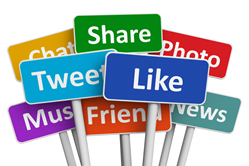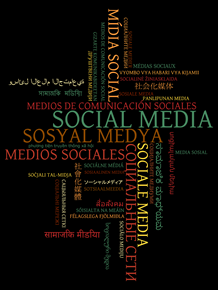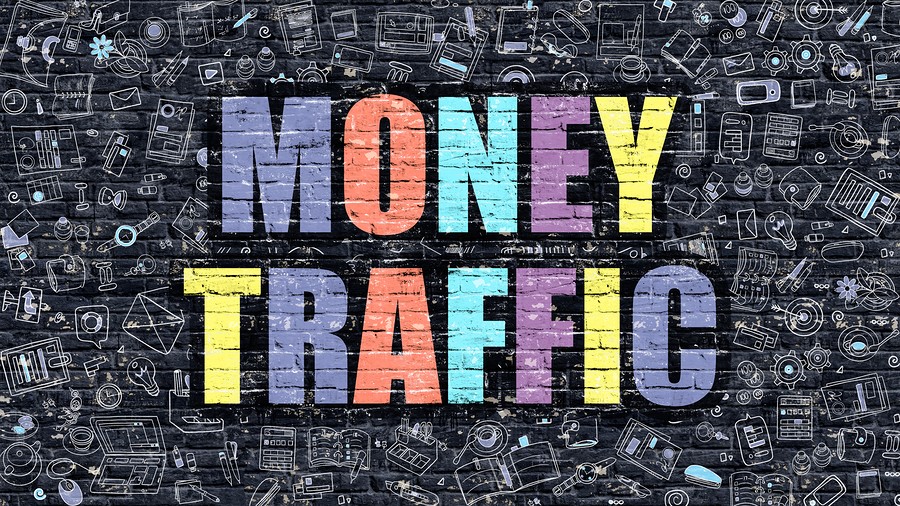Top 10 Guide: The Social Networks of 2016

The landscape of social networks has changed in every single one of the twelve years since Chris DeWolfe and Tom Anderson launched Myspace, the first online social network sensation. Today, social media is dynamic and increasingly diverse as new networks like Instagram and Snapchat take on Facebook’s dominance.

This guide outlines this year’s top ten social networks: from familiar sites and apps like Facebook and Snapchat to foreign favorites like China’s QZone and Russia’s Vkontakte. These platforms each boast unique features – from the basic to the novel – that let users share their lives online.
Rural folk use social media a little differently than the rest. They are, for example, more likely to use the idea-sharing social network Pinterest than the urban and suburban crowd. (What can I say? Do it yourself is the pioneer spirit.) This guide has a rural slant, focusing particularly on trends in rural demographics and on how each network works for you, the rural user.
The Finishers
#1 |Facebook
Mark Zuckerberg’s social media behemoth, has 1.4 billion monthly active accounts worldwide. Facebook is the most popular social network in the Americas, Europe, Africa, the Middle East, and Oceania.
Facebook is, really, the utility of the social media world. It offers users basic features like a public profile, business pages, private messaging, and text-, photo-, and video-sharing. As is standard with social Facebook users come from all walks of life, including a diverse spread of ages. Overall, they are the oldest of any social network (and getting older). eMarketer predicts that, throughout 2015, users 65 and older will be the fastest growing group of Facebook users.

Because its features are so basic, interest in Facebook is just as high in the country as it is in the city. According to a Sprout Social study, 69% of adults (18 and older) living in rural areas use Facebook. This number is pretty much on par with Sprout Social’s statistics for urban use (71% of adults) and suburban use (72% of adults).
#2 | QZone
You may never have heard of the Chinese social network QZone, but it is second in worldwide popularity only to Facebook. The blogging site boasts 630 million active accounts and its parent service, QQ instant messaging, boasts 830 million. Most QZone users live in China, where other social media platforms are blocked.

QZone is owned by the investment holding company Tencent, which also owns a handful of other social media and gaming platforms. The company maximizes integration between its online services (some of which are paid) so that users need only one login to access all of Tencent’s holdings.
Analysts compare QZone’s blog-based interface to MySpace’s. The site’s features – customizable themes and background music – let users self-express in a way Facebook does not. Advertisers, however, find blogging a less attractive platform than microblogging (a la Facebook and Twitter) and Tencent’s revenue falls far short of Facebook’s.
#3 | LinkedIn
LinkedIn, the professional networking tool, has 350 million active accounts worldwide. According to a Pew study, half of all college graduates in the United States are on LinkedIn.
LinkedIn’s features – a public resume and closed circles for college alumni, businesses, and organizations – support users’ professional development. Recruiters use LinkedIn to find and verify job candidates. A Herd Wisdom study found that 10.2 million applicants found their job through LinkedIn and that 89% of recruiters have hired someone through the social network.

In rural areas, LinkedIn is half as popular as it is in urban and suburban areas. According to a Sprout Social study, just 14% of adults (18 and older) living in rural areas use LinkedIn. Indeed, traditional rural occupations like agriculture are vastly underrepresented on the site.
LinkedIn users are overwhelmingly corporate and, really, that is the intention of the social network. There are, however, pockets in the agricultural industry that do see benefit from LinkedIn. A survey by CropLife Media Group found that, while half of farmers and agriculture retailers have a negative opinion of social media overall, 30% of retailers and 41% of managers use LinkedIn for business.
#4 | Instagram
The photo-sharing site Instagram has 340 million active accounts. Facebook bought the social network for $1 billion in 2012, just fifteen months after it was launched. At that time Instagram had thirteen employees and no revenue stream to speak of.
Instagram is a photo and video-sharing app for smartphones. Its features include filters (for easy photo editing) and hashtags. In contrast with Facebook albums, which support a high volume of photos, Instagram streams have users choose quality over quantity.

According to a Piper Jaffray study, Instagram was the most popular social network for teens in 2014. The research firm found that, at the end of 2014, 76% of teens used Instagram, while just 45% used Facebook. While other studies dispute these percentages, Instagram is consistently ranked one of the two social networks with the youngest demographics.
Add to that the fact that Cowen Group analysts project that the number of Instagram users will double in the next five years and Instagram looks like the future of social media.
According to a Sprout Social study, 19% of adults (18 and older) living in rural areas use Instagram. This means rural users are significantly less interested in Instagram than city dwellers, although excluding users under 18 (a significant portion of Instagram users) makes this statistic less relevant. Instagram is, after all, a young person’s game.
#5 | Twitter
Hollywood and Gaza’s favorite social network, Twitter, has 290 million active accounts. These users include many celebrities, politicians, activists, and other public figures who interact with the public on the social media platform.
Twitter users share short text or photo messages with one another. The site reduces the microblogging platform to its bare essentials –posts are always 140 characters or less. Twitter groups similar messages together based on their hashtags. This facilitates a public discourse on any and every topic.
Twitter pioneered the use of social media by public figures when it
introduced verified accounts and following. The verified account feature allows celebrities to use social media with authority (and strips power from fake accounts). The follow feature on Twitter, like on Instagram, lets users follow (one directional) instead of friend (two directional) each other. This lets public figures reach a much larger audience than previously possible.

Twitter’s ability to mobilize users, as it did during the “Twitter Revolutions” in Moldova, Iran, Tunisia, Egypt, and Ukraine, make the site vulnerable to censor. Twitter is blocked in North Korea, China, and Iran and has been censored or temporarily blocked during times of unrest in other countries.
According to a Sprout Social study, 17% of adults (18 and older) living in rural areas use Twitter. This number is significantly less than Sprout Social’s statistic for urban use (25% of adults). It could be that Twitter’s role as a town crier is not as relevant in sparsely populated areas.
#6 | Tumblr
Microblogging site Tumblr comes in sixth, with 230 million active accounts worldwide. The site’s founder, David Karp, built Tumbler’s streamlined, minimalist layout as a reflection of his own personal aesthetic (he famously owns one suit). His design turned out to be the perfect foil for the explosions of creative content that are Tumblr blogs.
Tumblr lets users share multimedia content like images, GIFs (a term Tumblr is credited with coining), text, Spotify tracks, mp3s, and video. Content spreads from user to user through the reblogging feature, which also prevents copyright violations. Tumblr hands users a lot of creative control – while most top social networks have rigid design schemes, Tumblr users have the unique ability to write their own page themes in HTML.
The site’s features are most attractive to those with creative hobbies like fashion, art, or writing. Emotive self-expression is the name of the Tumblr game. The site is also a platform for crowd-sourced projects like the feel good #PostItForward campaign.
One of Tumblr’s most recent #PostItForward posts is dedicated to small-town kids with big-city dreams, a profile that sums up many of Tumblr’s rural users. Indeed, Tumblr is not a social utility like Facebook, but a niche network that attracts artistic, self-expressive users to a like-minded online community.
#7 | Snapchat
Mobile app Snapchat has 200 million active users, 80% of whom live in the United States. Every day, users take 700 million photos on the photo- and video-sharing platform.

Snapshat users take photos and videos with the app, add text or drawings, and send the result (the snap) to one or more friends. Snaps are impermanent. The sender determines how long they will appear on a friend’s phone, anywhere from one to ten seconds.
Snapchat was originally marketed to those concerned with onlineprivacy. The company claimed that the temporary nature of a snap protected sensitive content (nudes, etc.) from hackers and surveillance programs. Since then, a number of security breaches and questionable privacy policies have revealed that Snapchat may be the least reliable social network when it comes to protecting users’ information.

Although it is not a reliable way to transfer sensitive content, people still use Snapchat because it’s fun. Posts on other social networks are permanent and, therefore, permanently available for scrutiny by friends, family, and coworkers. As a result, users often tightly control their online image on these platforms. Snapchat, on the other hand, lets users be silly or inappropriate. It’s the casual social network.
#8 | Sina Weibo
China’s microblog Sina Weibo has 170 million active accounts. Opportunist Charles Chao launched the site in August 2009, a month after the riots in Urumqi and the government’s subsequent ban of Facebook, Twitter, and Fanfou (China’s first microblogging site). Unlike its predecessors, Sina Weibo cooperates with Chinese officials on censorship.

The content of both the Chinese and English versions of Sina Weibo is subject to government review. Considering the potential of the Chinese market, Sina Weibo has a relatively small active user base. Analysts have postulated that tight government control discourages users from utilizing the site.
Like Twitter, Sina Weibo lets users post up to 140 characters of text at a time. The concentrated microblog format means the network is most often compared to Twitter, but Sina Weibo has many features – threaded comments, imbedded multimedia, a rewards system (rewards seem to be a staple of Chinese social networking, QZone has them too) – that Twitter does not.
Users in the West, whether urban or rural, are most interested in Sina Weibo as a means to penetrate the Chinese consumer market. The site recently announced a collaboration with the online marketing firm Socialbakers, who will be developing a panel (like Facebook Insights) to track businesses’ success on the site.
#9 | Vkontakte
The Russian social network Vkontakte or VK has 100 million active accounts, mostly in Russian-speaking Eastern Europe. Young entrepreneur Pavel Durov developed the site in 2006 as the Russian version of Facebook.
VK’s design and functionality are similar to Facebook’s. Like Facebook, VK supports public profiles, posting, sharing, private messages, groups, and pages. The social network is integrated with both Facebook and Twitter, so that VK posts can be shared seamlessly on either network and vice versa.

Russian copyright law is much more lenient than American copyright law. Russian courts have ruled multiple times that VK is not liable for its users’ copyright infringement on its site. As a result, VK users can upload and share full-length movies with each other without repercussions from VK. It was only last year that VK announced it will seek to legalize its video content by 2016.
Beginning in 2011, founder and CEO Durov began resisting requests for information about VK users from the government. An outspoken opponent of surveillance (he famously offered Edward Snowden a job), Durov made users’ privacy a priority. Then, amid the unrest in Ukraine, shareholders sympathetic to the Kremlin bought control of the company. Facing pressure to hand over information about opposition leaders, Durov resigned in protest.
#10 |Pinterest
The idea-sharing social network Pinterest has 73 million active accounts, mostly in the United States. A childhood love of collecting inspired the site’s founders who, with Pinterest, created a way to collect the Internet. Pinterest is a virtual bulletin board for images and, less frequently, video clips. Users, and brands like L.L. Bean and Martha Stewart

Living, add these images and video clips (called pins) to Pinterest. Users search or browse pins and build their own idea boards on subjects like weddings, gardening, cooking, travel, and fashion. Users can also follow other users’ boards instead of creating their own.
Many pins are “how to”s. There’s a tutorial on Pinterest on how to do anything from braid a fishtail braid to fold a fitted sheet. Because Pinterest is visual, the platform lends itself to material projects best (more building and less pondering). Because 80% of Pinterest users are female, the content is overtly or inadvertently curated for a female audience.
According to a Sprout Social study, 30% of adults (18 and older) living in rural areas use Pinterest Rural adults are more likely to be on Pinterest than urban or suburban adults. The site’s content – gardening, home improvement, rustic charm – reflects and attracts interest from rural dwellers.

Honorable Mention
#11 | Google +
Google+: Infamously unpopular, Google’s social network has 4 to 6 million active users. As Google dissolves the social network (the most recent extraction: Google Photos), its parts are proving to be more than the sum of its whole.
When it comes to online platforms, integration is usually considered a
good thing. The struggles of Google+ (alongside the success of dis-integrated app Snapchat) reveal the limits of integration. It turns out few people want to comment on YouTube with the same profile they handle professional or personal emails. Google, however, hasn’t yet given up on Google+. Stay tuned for another redesign of this social network this year.






